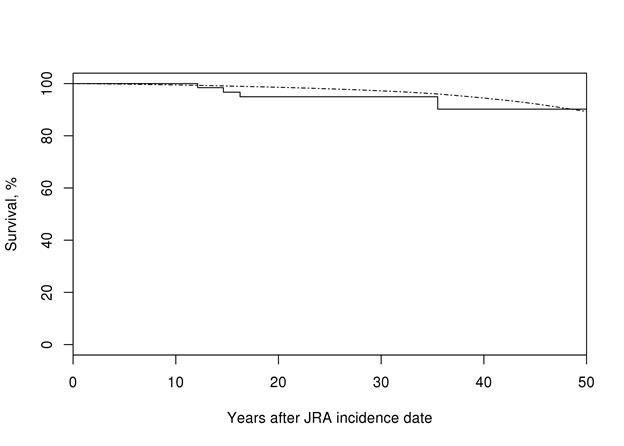Session Information
Date: Monday, November 9, 2015
Session Type: ACR Poster Session B
Session Time: 9:00AM-11:00AM
Background/Purpose:
Information regarding incidence, prevalence, and mortality in juvenile
rheumatoid arthritis is scarce, particularly since the advent of recent
classification criteria for juvenile inflammatory arthritis (JIA). Estimates
are based on varying populations, classification criteria, follow-up durations,
and disease validation methodology.
Methods: Incident
cases of juvenile arthritis were identified between January 1, 1994 and
December 31, 2013 in a geographically well-defined population using individual
medical record review for case validation. Cases meeting ACR criteria for
juvenile rheumatoid arthritis (JRA) and ILAR criteria for juvenile idiopathic
arthritis (JIA) were included. Individuals who met criteria for JRA were
combined with a prior cohort of incident cases from 1960-1993.1 Incidence
and prevalence rates with 95% confidence intervals (CI) were sex- and
age-adjusted to the 2010 U.S. white population. The standardized mortality
ratio (SMR) with 95% CI was calculated with expected deaths based on age, sex
and calendar year specific life tables for the U.S. population and displayed
using Kaplan-Meier methods.
Results: Fifty-nine
incident cases met JRA criteria in 1994-2013. Disease subtypes included 48
(81%) with pauciarticular disease, and 9 (15%) with polyarticular and 2 (3%)
with systemic disease. These JRA patients were combined with the additional 59
patients from the previously identified 1960-1993 cohort for a total of 118
patients. There were no differences in the subtypes of JRA, age at diagnosis,
sex, or time from symptoms to diagnosis comparing the 2 cohorts. The incidence
of JRA in 1994-2013 was 9.5 per 100,000 (95% CI 7.1, 12.0). Prevalence of JRA
on 1/1/2010 was 54.4 per 100,000 (95% CI 28.5, 80.2). There was no significant
change in the incidence of JRA over the entire time period.
Utilizing JIA criteria, 71 incident cases were
identified in 1994-2013. Incidence was 10.3 per 100,000 (95% CI 7.9, 12.7).
Prevalence on 1/1/2010 was 57.6 per 100,000 (95% CI 31.0, 84.5). Oligoarthritis
was the most common subtype accounting for 63%. Joint erosions were noted in
17% and eye involvement in 7%.
A total of 4 deaths occurred during 2180.7
person-years of follow-up in patients with JRA. No deaths have occurred in
children with incident JRA in 1994-2013. None of the deaths were directly
related to juvenile arthritis. The SMR was 1.50 (95% CI 0.41-3.83); the survival
curve is shown in figure 1.
Conclusion: The
incidence of JRA did not change significantly between 1960-2013. Incidence is
higher when using the more inclusive criteria of JIA as compared to JRA. When
specifically evaluating the more homogeneous group of patients who met ACR JRA
criteria, there was no demonstrated increase in mortality compared to the
general population.
1Peterson
LS, et al. Arthritis Rheum 1996;39(8):1385-90.
To cite this abstract in AMA style:
Krause ML, Crowson CS, Michet CJ III, Wampler Muskardin T, Mason T II, Matteson EL. Incidence and Mortality in a Population-Based Cohort of Patients with Juvenile Arthritis 1960-2013 [abstract]. Arthritis Rheumatol. 2015; 67 (suppl 10). https://acrabstracts.org/abstract/incidence-and-mortality-in-a-population-based-cohort-of-patients-with-juvenile-arthritis-1960-2013/. Accessed .« Back to 2015 ACR/ARHP Annual Meeting
ACR Meeting Abstracts - https://acrabstracts.org/abstract/incidence-and-mortality-in-a-population-based-cohort-of-patients-with-juvenile-arthritis-1960-2013/

